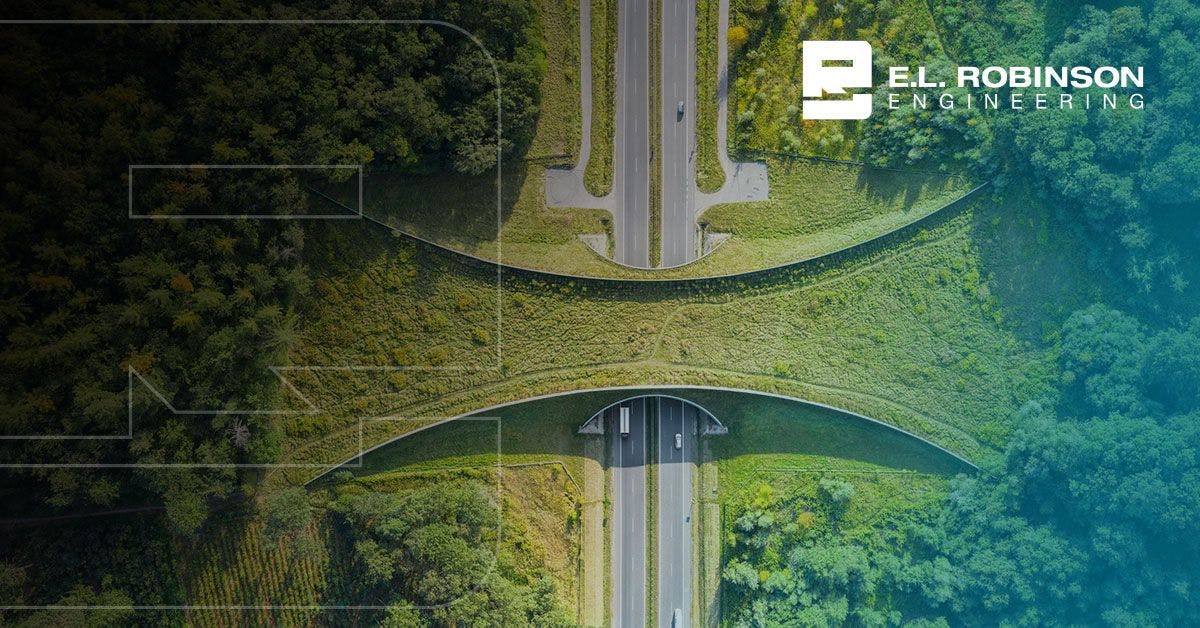Aug 03, 2022Safe Passage for Creatures Great and Small

How Engineered Fish Passage and Wildlife Crossing Structures Help People and Animals
Did you know that civil engineers, structural engineers, and landscape architects all work with environmental planning professionals to ensure the preservation and protection of the wildlife in the area surrounding the parks, bridges, highways, and other structures we design and build?
It’s true, and we have a highly experienced and respected Environmental Planning team that conducts studies and assessments, consults with our engineers, and advises on elements like wildlife crossing and aquatic organism passing requirements.
There are a number of ways to facilitate safe fish passage and wildlife crossing through engineered structures like culverts and land bridges. First, we’ll look at why this is necessary, then we’ll dive into a bit more detail about what these structures are and how they work.
Environmental Challenges of Human-Made Structures
The roads and other structures that we build that are vital and connecting infrastructures for humans may potentially have the opposite effect on fish and wildlife. The structures often divide the natural landscape for wildlife species that need to cross roads to find food, water, and suitable habitat. The divisions aren’t just disruptive; wildlife-vehicle collisions (WVCs) can be deadly for wildlife. They’re no picnic for the humans involved either.
The challenge is not limited to land-based animals. When designing a new park, road, bridge, or other types of infrastructure project, civil engineers must take into account the potential impact it will have on local aquatic organisms and fish.
According to the US Fish & Wildlife Service (USFWS) Fish Passage Program, “Fish passage is the ability of fish or other aquatic species to move through an aquatic system among all habitats necessary to complete their life cycle. Fish need connections between and within waterways during various life stages to reproduce, feed, and contribute to their ecosystems by recycling the nutrients they take in… Barriers that block the natural movement of fish are a major cause for the decline in fish populations. Today, millions of obsolete or poorly designed dams, roads, and levees in the U.S. keep fish, and other aquatic species from moving freely to feed, migrate, and reproduce.”
Engineered Structures that Connect for Wildlife Crossing and Fish Passage
If you explore sites like the USFWS page linked above, you might think at first glance that all structures are barriers. But human-made structures are not always the problem. Designed properly, engineered structures can help ensure that natural and infrastructure barriers don’t isolate previously connected habitats or limit the ability of wildlife to move between these areas.
We’ll focus on two examples of structures that can connect instead of divide habitats: Culverts and Land Bridges.
Culverts for Safe Fish Passage and Wildlife Crossing
A culvert is a structure usually made of concrete, PVC, aluminum, or galvanized steel pipe. Culverts allow water and related wildlife to pass beneath other structures like trails, ditches, roads, and railroads.
Our engineers and environmental professionals ensure that we design with the environment and wildlife in mind, but not everyone does that. Culverts are often seen as barriers because they are not always designed to accommodate the environment, fish, or wildlife crossings. When poorly designed, improperly placed, or undersized, it’s true that they can do more harm than good.
“Think of it like a drinking straw,” explained Marella Buncick, E.L. Robinson Senior Environmental Planner, Ecologist, and former long-time USFWS employee. “Anything bigger than the straw’s diameter, ice, for example, won’t go through. Now imagine that straw is a giant structure in a stream. If the straw -or culvert in this case- is too small for the fish and other aquatic organisms in the environment, then it’s a barrier and a problem. If it’s designed according to the National Environmental Policy Act (NEPA) requirements to accommodate the fish and wildlife in the local ecosystem, it is a connector and a solution.”
Well-designed culverts provide significant benefits to wildlife populations and help to preserve native biodiversity. Other structures that specifically help fish pass through barriers like dams include fishways, fish ladders, and fish lifts. Requirements are dependent on the local environment and species and are often specified at the local level. To find information specific to your state, visit the Association of Fish & Wildlife Agencies (AFWA) State Wildlife Action Plans.
Supporting Safe Wildlife Crossing Via Land Bridges
A land bridge is an artificial bridge that connects two areas of natural habitat for safe wildlife crossing, even if there’s no obvious path between them. They may be temporary or permanent, can vary widely in size, and can be as simple as a dirt mound that lets animals climb over a road, or as complicated as a manmade lake that allows aquatic species to travel from one body of water to another.
Land bridges can also benefit plants, especially in areas that are experiencing drought, and can help to promote the survival of threatened or endangered species such as the Indiana Bat and the Preble Fishhook Cactus. They can also help address problem areas that have human traffic within a natural habitat, as with Grizzly Bears in Canada.
Talk to E.L. Robinson Engineers and Environmental Planners
If you have a park and recreation, transportation, utility, or another project that might involve a wildlife crossing, fish and aquatic organism passage, or other potential environmental impacts, contact us to make sure it’s designed to minimize negative effects and maximize positive outcomes for humans and other wildlife.
For more wildlife crossing information and videos, check out May 31, 2021, New York Times article “How Do Animals Safely Cross a Highway? Take a Look” by Catrin Einhorn.